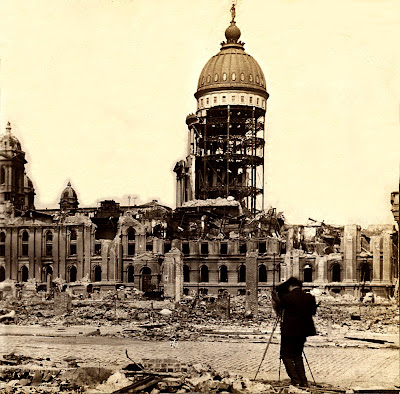The California earthquake of April 18, 1906 ranks as one of the most significant earthquakes of all time, firefighters finally halt the spread of flames two days April 20. Today, its importance comes more from the wealth of scientific knowledge derived from it than from its sheer size. Rupturing the northernmost 296 miles (477 kilometers) of the San Andreas fault from northwest of San Juan Bautista to the triple junction at Cape Mendocino, the earthquake confounded contemporary geologists with its large, horizontal displacements and great rupture length. Indeed, the significance of the fault and recognition of its large cumulative offset would not be fully appreciated until the advent of plate tectonics more than half a century later. Analysis of the 1906 displacements and strain in the surrounding crust led Reid (1910) to formulate his elastic-rebound theory of the earthquake source, which remains today the principal model of the earthquake cycle.
Title: City Hall after the earthquake, showing the shattered foundations, San Francisco, Cal. Creator(s): Griffith, Geo. W., Date Created/Published: Philadelphia : Geo. W. Griffith, c1906. Medium: 1 photographic print on stereo card : stereograph.
Summary: Stereograph showing ruins of City Hall following the earthquake and fire in San Francisco, 1906, with photographer using camera on tripod in foreground. Reproduction Number: LC-DIG-ppmsca-09828 (digital file from original stereograph)
Rights Advisory: No known restrictions on publication.
Call Number: LOT 11523-4 [item] [P&P] Repository: Library of Congress Prints and Photographs Division Washington, D.C. 20540 USA
Notes:
* H81824 U.S. Copyright Office.
* No. 39.
* Sold only by Griffith & Griffith.
* Title from item.
* Exhibited: Documenting Disaster: Photographs of the 1906 San Francisco Earthquake and Fire, San Francisco Museum of Modern Art, San Francisco, California, 2006.
TEXT RESOURCE: Welcome to the USGS - U.S. Geological Survey















2 comments:
AQ
THATS ALOT OF DAMAGE LOL
Post a Comment